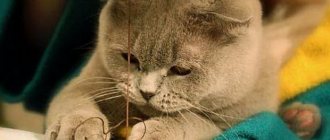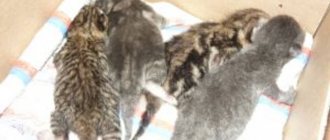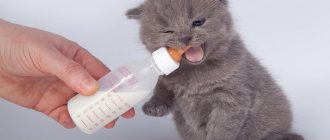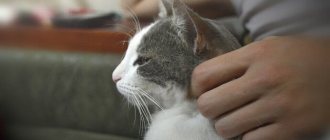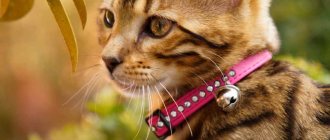You can’t describe the character of a British cat in a few words. It’s the same as saying about Napoleon’s life “he led France.” Only, the British are not French. They are proud, sometimes arrogant. We are talking about cats, about them - cats of the British breed.
Only this fact does not mean that representatives of the breed never want to be petted. They want it, but when they need it, and not at the moment when the owner takes it into his head. This cat is a personality. He has an opinion that must be taken into account. To understand what kind of character British cats have, you need to watch them a little, or better yet, live in the same house for several weeks.
Features of the appearance of the breed
Representatives of the British breed are distinguished by their stockiness and unusual plush fur. Pets come in medium and large sizes. They are beautifully built and have good muscles. The fur does not adhere to the body, which is why pets look like plush toys. At the same time, it has a uniform length; often the undercoat has a darker color than the main shade of the coat. The limbs are short but strong.
The British breed is characterized by a large head with pronounced cheekbones. The eyes of the pets are wide open, the nose is straight, the ears are quite short, because of this the muzzle looks more rounded.
The color of the British is not only blue. Although mostly people have pets of this shade. Cats may not be the same color; uneven coloring of the coat is also allowed. Each shade has several variations, for example, lilac is divided into three types: light, medium, dark.
The British breed inspired Lewis Carroll to create the Cheshire Cat. The character was based on the wide and slightly smug muzzle of the British.
In fact, according to the breed standard, at least thirty types of colors are known:
- black;
- white;
- creamy;
- chocolate;
- lilac;
- ginger;
- tortoiseshell;
- marble;
- chinchilla;
- brindle;
- mackerel;
- smoky;
- tabby;
- spotted.
conclusions
Perhaps one day an arrogant British cat will jump onto your lap and delight you with her simple song. Despite their genetically inherent independence and self-sufficiency, British cats have the ability to be grateful and love their caring owner.
Cats are quite capricious, freedom-loving, independent animals. Each individual, even within the same breed, has its own disposition, temperament, habits, and character. Some mustaches constantly require the attention of their owners and literally do not get off the laps or hands of their beloved owner, others are reluctant to make contact with a person and allow themselves to be stroked and cuddled only when they have the desire and the mood. How to raise an affectionate, easy-going pet? How to accustom a kitten to being held? You will learn the answers to these questions from this article.
Unfortunately, not all small kittens are happy to sit quietly and spend time in the arms of their owner, especially in stressful situations or if the pet is very scared. In addition, not all furry cats require increased attention and avoid close contact with humans. This applies not only to wild street adult cats, cats of certain breeds, but also to kittens that you came out of a helpless little lump. But you really want to cuddle and caress your beloved pet.
Cats tend to be arrogant. In most cases, cats allow themselves to be loved, accept our care, guardianship, and attention. Even a small kitten will not always sit quietly in your arms, allowing itself to be squeezed for hours. Remember that cats are very capricious and freedom-loving animals.
Why don't cats like to be held? The reasons for this behavior may be the following:
- Breed characteristics, genetic predisposition.
- Fear of heights, loss of balance. There are cats that are afraid of heights, weightlessness and do not like balance. Sitting in your arms, the kitten experiences fear and discomfort.
- Incorrect socialization, adaptation.
- Frequent stressful situations, mobile type of nervous system. If the cat is frightened or has suffered a strong attack, even the calmest kitten, experiencing anxiety, will try to escape from the hands and run to a safe place.
- Rough treatment of animals. Cats remember their abuser very well, and if you used physical violence, the pet will no longer fully trust you.
- Strong unpleasant odors, according to the cat, emanating from the owner and his hands. Cats do not like the aroma of perfumes, especially citrus notes, or the smell of tobacco. Perhaps you have previously petted another cat or dog and the smell of the “stranger” scares the kitten away.
Tea dictionary
| Aroma | Aroma |
| Boling water | Boiling water |
| Brew | Welding |
| To brew tea | Brew tea |
| Ceylonese tea | Ceylon tea |
| China | 1) China 2) Porcelain |
| China tea | Chinese tea |
| Cup | Cup |
| Curd | Kurd, custard |
| Darjeeling | Darjeeling (type of tea) |
| Earl Gray | Tea with bergamot |
| Green tea | Green tea |
| Herbal tea | Herb tea |
| Indian tea | Indian tea |
| Kettle | Kettle (for boiling water) |
| Lump (of sugar) | Sugar cube) |
| Milk | Milk |
| Mint tea | Tea with mint |
| Oolong | Ulung (type of tea) |
| Saucer | Saucer |
| To stir | Mix |
| Scone | Scone, classic English muffin |
| Strong tea | Strong tea |
| Sugar | Sugar |
| Taste | Taste |
| Tea house, tea shop | Tea house, teahouse |
| Tea leaves | Tea leaves |
| Tea strainer | Tea strainer |
| Teapot | Teapot, teapot |
| Teaspoon | Tea spoon |
| Weak tea, watery tea | Weak tea |
| White tea | White tea |
Character traits
The character of the British is formed before one and a half years. If you miss time, it will be difficult to re-educate the cat.
The British breed has a special temperament. Cats do not tolerate humiliation and rudeness. With the right approach, they behave in a dignified manner, do not destroy the house, do not bite, or spoil things. You cannot limit their freedom by trying to grab them and carry them in your arms all the time. If the owner shows aggression towards the pet, then in the future the animal will hide and may even refuse food.
The pet will not show its owners weaknesses. He will not take revenge, like representatives of another breed, by tearing off wallpaper or ruining shoes. The British may spend a lot of time at home alone. But, despite their independence, they need attention and affection.
Representatives of the British breed are extremely patient; they do not react to minor mischief. Therefore, they get along well with all the inhabitants of the house. But if a cat is hurt, it will defend itself by using its teeth or claws.
Why won't my cat sit in my arms?
There are several reasons why cats do not like to sit in their owner's arms:
- Character. There are individuals who love loneliness and solitude; they do not like close communication with humans. They can tolerate being picked up by their owner, but will run away at the first opportunity. The reason for this behavior lies in the pet's temperament.
Due to its nature, a cat may simply be offended by its owner and refuse to sit in his arms, demonstrating dissatisfaction.
- Features of the breed. Dislike for weasels may lie in belonging to a certain species. In this case, independent individuals are considered Scottish (loose-eared and straight-eared), British shorthair cats and Maine Coons. They are usually very independent. These pets do not like to be held. The most they can allow is to stroke themselves. Mongrel animals, on the contrary, love contact with humans and willingly go into their arms, experiencing true pleasure.
- Shy individuals. If no one caressed or stroked a small kitten at a young age, then with age he will not have the need for this. An adult animal will be afraid of this behavior. Another reason is a negative attitude in the past on the part of the owner (if the cat was constantly beaten and scolded). In this case, any touch will cause hostility in the pet. Only patience and sensitivity can help a cat get rid of this disease.
Chocolate Briton - photo, description and character
How to raise a cat - habit formation, punishment, praise
Habits, unlike character, are formed throughout the pet’s life. Therefore, owners, with a little effort, can raise a cat correctly. The main thing is to immediately let your pet know who is in charge in the house.
The British are considered very clean. Kids imitate their mothers in everything, adopting her good manners. So, in order to accustom a kitten to the tray, a couple of days are enough. Adults regularly wash themselves and clean their fur. But at the same time, they don’t like it when their owners start fiddling with their fur.
Bad habits
British cats love to drop objects from heights. They like to watch the process of falling. As soon as the owners notice this prank, they should immediately scold the animal. To wean your pet from climbing into prohibited places, you need to treat the surfaces with a special product.
A kitten under four months of age may bite and scratch as it is teething. If this continues into adulthood, then this indicates improper upbringing. Therefore, it is worth initially giving the British toys that can be bitten instead of the owners’ hands.
The most harmless bad habit is checking bags and packages. It is difficult to wean your pet off of this, but it is worth scolding him for such tricks so that a reflex is developed.
Should a Briton be punished or praised?
If a pet has committed an offense, then you need to scold it immediately. Otherwise, he will not understand the essence of the claims. Moreover, the British will harbor a grudge and prefer to be as far away from you as possible.
The carrot and stick rule works with animals, as with people. That is, the animal will develop reflexes not only to punishment, but also to praise. It is advisable to notice positive changes in the cat’s behavior by talking about it out loud.
What not to do
Even if the kitten is reluctant to make contact, does not want to sit quietly on your hands or knees, never scream, and especially do not hit the animal. Violent disrespect will only make the situation worse. Just patience and consistency in action.
Do not grab the kitten by the scruff of the neck, do not pull the front legs, and do not make sudden movements.
The animal should not feel that you are a threat. Your hands should evoke only positive associations. Make the animal want to sit on your hands and lap.
It happens that a cat flatly refuses to stay in the owner’s arms for a long time and tries by all means to break free and run away. The wrong approach when trying to place a pet on your lap can cause discomfort for it. It is also possible that the animal has been beaten before or does not like close contact due to its breed. It is worth understanding the reasons for this behavior and learning how to properly hold the animal in your arms.
Aggressive cat: what to do and where to run
Cats are very sensitive creatures with a subtle psychology, so their behavior is significantly influenced by external factors, especially strong emotions such as fear.
A cat that is afraid of something takes a characteristic pose - it presses its ears tightly to its head and moves them back, presses its head and body to the ground, tries to become more invisible, in many cases the animal simply tries to run away.
If it doesn’t run away, it tries to defend itself. A cat that is ready to defend itself looks like this - it raises its paws and swings them, makes sounds similar to spitting, hisses, its fur stands on end (especially on the tail, head and back), its back arches and the animal moves sideways forward, so a cat tries to show its superiority (including in size) and intimidate the enemy.
In most cases, fear is the main cause of aggression in cats. If your pet is timid, you should never deliberately provoke fear; you should also ask your friends and acquaintances to approach the animal slowly, not abruptly, and say kind words as they do so. Only in this way can possible aggression on his part be neutralized.
If the cat is ready to attack, is aggressive, you can spray water on it from a spray bottle, this will cool its ardor. If an animal scratches a smooth surface out of despair, it means that it has lost control of the situation. In this case, you need to put some kind of rug on the cat so that she can sharpen her claws on it, or wrap her in a warm cloth - this way the cat will calm down faster.
Another reason for cat aggression is defense of territory. If there are several animals living in your home, especially if you are the owner of several cats that have reached sexual maturity, they may begin to fight for leadership. To prevent this from happening, introduce the cats correctly in the first days.
The animal that lived with you before should definitely receive more attention - this way it will not feel threatened and will not become jealous. As a rule, cats that live together eat from the same bowls and use the same litter box, but this can cause aggression. Cat utensils should be separated as soon as you notice that the animals are demonstratively avoiding the litter box or fighting around the bowls.
Different smells of animals can cause them to fight, so the manifestation of aggression of one pet towards another can be reduced by bathing them with the same shampoo or spraying them with the same cologne.
Neutered cats, as a rule, are less aggressive, and even sworn enemies can be reconciled. But it is better to castrate animals between the ages of seven months and 1 year, until they acquire the habit of showing aggression and marking territory.
Often those who keep cats confuse their bites with aggression. Small kittens may bite you because their jaws itch (due to teething). Invite them to chew bones, but only those that they cannot chew, or large pieces of meat. Never feed bones from small animals and birds, or chicken bones, as kittens can chew them, causing damage to the gastrointestinal tract.
Often, when the owner tries to pet his pet, he may begin to bite, especially if you want to scratch the cat’s tummy (the stomach for cats is the most vulnerable place, if the animal allows you to scratch its tummy, it means it is subordinate to you and completely trusts you). However, this does not always mean that the cat is aggressive; most likely, your pet is simply not in the mood for communication at the moment or she does not like your affection.
Under no circumstances should you hit cats that show aggression - this will only make the situation worse. If possible, you need to eliminate the cause of the aggression and cool the animal’s ardor with a stream of water.
The following method may also help. You've probably seen how cats behave during fights (swinging their paws at each other, hissing) or mother cats with their children (ruffling them and holding them by the withers). You must do the same - lightly shake the animal by the scruff of the neck, lightly tap it on the nose with your finger, imitate the waving of cats' paws during a fight, hiss at it menacingly and be sure to look the cat in the eyes, since the one who looks away first will “lose” - These are the cat “rules”. You must ensure that your pet looks away, he will become somewhat confused, begin to hesitate, may begin to leave or lick himself - this all means that the animal has recognized you as the leader.
Did you like the article? Click the button and share with your friends! Let there be more happy people and cats!
brit-cats.ru
How to properly hold a pet
First, it’s worth considering the basic rules for handling animals:
- Do not hold a cat against its will. If the animal doesn’t like it, it still won’t sit in your arms, so it’s better to let it go.
- Do not put too much pressure on your torso. If a cat is hurt, it will remember it and try to avoid such contact in the future.
- If your pet meows loudly, this is a signal that he is in pain or uncomfortable.
To pick up a pet, you should follow the following sequence:
- 1. Make sure the cat is free and friendly.
- 2. Approach him without sudden movements.
- 3. Call him affectionately, pet him or scratch him behind the ear.
- 4. If a cat purrs and looks into the eyes, this means that he is not against close communication with a person.
- 5. With one hand you need to grab the animal under the body by the front legs, with the other - by the hind legs and carefully lift it.
- 6. To make your pet feel comfortable, it is better to hold him close to you.
It is correct to hold a cat in your arms near your chest. You can’t restrict his movements, just lightly press him towards you. It is necessary to monitor the position of the pet's body; it should remain almost straight, without sagging or falling upside down. The cat's head should be slightly higher than its body. If the animal becomes uncomfortable, it will begin to break out of your hands, scratch or bite.
How to bathe a cat
The British are clean, but they still need to be bathed sometimes. To do this, you must use special tools and follow the following rules:
- the pet should be placed in a basin filled one third with warm water;
- When applying shampoo, you should support the cat under the neck;
- The soap product must be washed completely; a shower and a comb may be useful for this.
After bathing, the animal must be wrapped to dry the fur. When it dries, you can comb it carefully.
Reasons for behavior
Cats are freedom-loving and self-sufficient animals. Professional trainers know that it is almost impossible to force them to do something against their will, even force a cat to sit in your arms. Cats have different personalities from each other, just like people. Some are more affectionate, patient, friendly and capable of purring for a long time on their owner’s lap, others are strict and independent, not allowing themselves to be simply petted. British shorthair and fold-eared cats are especially susceptible to this. Often the cat chooses its own place in the apartment and, if it does not want to sit in your arms, nothing can be done, but sometimes it can be tamed.
Description
The external characteristics of these animals are as follows:
- A rounded head, large cheeks, a straight and short nose, low-set small ears, large open eyes, most often golden in color.
- A muscular body with wide bones, a wide torso and a massive back, short limbs, the weight of females is on average five kilograms, and in males it can reach up to eight.
- Thick shiny fur. There are short-haired and long-haired Britons, the former have plush and delicate fur, the latter have a good undercoat and gorgeous pubescence of the tail, collar and panties.
- Two or one color, the most common are black, blue white, lilac, cream and red cats. There are also tabby and ticked specimens.
If an animal has too pronounced antler caps, a long hooked nose, or sharp facial features, this is considered a fault.
Independent types of cats
The breed of a cat often speaks about how it relates to pets and people.
Breeds such as the British Shorthair and Scottish Fold are famous for their independent habits; they do not want to sit in a person’s arms or feel delighted at the sight of their breadwinner. In other words, they are not trying to curry favor with the “higher authorities,” but, on the contrary, they act from a position of strength and give the person the opportunity to only stroke himself. The above character can also be found in the inimitable Maine Coons. But not for everyone, since in life there are also friendly individuals who adapt to circumstances.
But mongrels easily make contact and rub against the owner’s legs, sit calmly in the arms and purr. True, among mongrel cats there are also aristocrats.
What to feed a Briton
An adult cat needs to be fed at least twice a day, and a kitten at least four times. Your pet should have a balanced diet rich in vitamins. A cat's diet can be represented by:
- natural food:
- boiled meat without bones and skin;
- liver;
- eggs;
- porridge;
- fish;
- vegetables;
- dairy products.
- ready-made food.
When choosing food, you should pay attention to the line of professional food intended for the British breed.
The British are friendly, moderately affectionate, and treat all family members evenly. And yet, a British cat should not be owned by families with small children who are eager to cuddle the animal. This breed will not allow itself to be made into a toy; accordingly, it will hide in corners and turn into a frightened animal. If you take into account the wayward character of the cat, then she will repay you with affection.
How to hand train a kitten
I will lie anywhere, but not sit in my arms
. Perhaps the British dislike for excessive affection lies in the history of the origin of this breed. There are several versions about this:
- Large gray cats with amber eyes were brought to the British Isles by the ancient Romans.
- French sailors acquired huge gray cats from the monks of Grand Chartres to protect food cargo on ships from rodents. Their ships regularly visited the shores of Britain. Therefore, some cats could remain on the shore.
- The breed of British cats with wide cheekbones, large expressive eyes and thick short hair was formed as a result of crossing immigrants with local tabby wild cats.
British cats have their own, independent and different character
Judging by the history of the origin of this breed, it can be argued that the independent character of the British comes from the harsh life on French ships, where none of the sailors coddled with them. Life among ascetic monks and proud Romans also left its mark on the independent character of these cats.
For centuries, their role was to live among people, mind their own business and earn their basic food.
Wild cat Tabby
British cats are distinguished by their intelligence and intelligence. When handled skillfully, they even... However, adapting their behavior to the mood of their owner, representatives of this breed under no circumstances lose their dignity.
For these cats, freedom and independence are a priority
These qualities are more developed in British cats than others. Despite the centuries-old history of the existence of this breed next to man, the animals did not completely submit to his authority. In many cases, the opposite happens: the cat inevitably dictates terms to its owner.
The British woman even lies like a king
British cats have real royal manners. Restrained by nature, they will not do what they do not consider necessary. All this does not mean that the British are too arrogant and prim. They love and appreciate affection, but accept it in their characteristic independent manner.
Cats of this breed are ideal for business people who are away at work from morning to evening, or even leave home for several days.
These cats demonstrate their affection when meeting their owner. Adhering to aristocratic manners, British cats will not get in the way, but will follow their owner around the house with dignity. They will happily play with the owner's children, lie next to them while watching the evening news, and allow themselves to be petted.
However, you shouldn't relax. The cat will not sit on your lap. And if you try to pick him up and force him to sit with you, it will lead to nothing. British cats do not tolerate familiarity. Therefore, they will gallantly dodge and, without unnecessary emotions, retire in English to where no one will disturb them.
The British woman doesn’t want to be held, she shows it all with her behavior
Otherwise, the cat will be wary of such attempts, and it will be difficult to establish the same contact with it.
You can try to accustom your kitten to holding hands. The sooner you do this, the sooner he will get used to it. However, if something doesn’t go well during the learning process, and the kitten stubbornly refuses physical contact, you should not insist. Moreover, under no circumstances should force be used. In this case, the animal will stop trusting the person and begin to hide from him.
When training a cat, you need to act gradually and not force things. It is important to carefully observe the kitten, understand when it is most inclined to contact and use this in further training.
Only affection, attention to the pet and observation of the owners can bear fruit. A skillful approach to the learning process and the desire to understand the character traits of your pet will help turn an independent, selfish Briton into a devoted friend.
How to train a cat to sit quickly in your arms? The complexity of this process largely depends on the age, character, temperament, breed characteristics, and upbringing of your mustachioed pet.
For example, a British or Scottish fold kitten will take longer to accustom. As a rule, kittens develop socialization skills from about the second week of their life. Therefore, from now on, you can carefully pick up the kitten in your arms, gradually accustoming it to hands and affection. The process of socialization and adaptation should be as favorable as possible for a small pet.
Accordingly, the sooner you accustom an animal to communication, the faster and easier it is to achieve the desired result. Even if you got a cat and he is not six months old, with the right approach, accustoming the animal to your hands and raising an affectionate pet will not be difficult. Especially if the cat had a positive experience in communicating with the previous owner or with a person.
- During the first days, do not bother your baby with your excessive attention. The little pet explores a new territory, gets used to the smells and surroundings. Everything is interesting and curious to him.
- Protect the animal from stress, communicate with the kitten in a gentle tone, but at the same time pay attention to the cat as much as he wishes.
- Do not squeeze or forcefully hold the animal in your arms if it breaks out. If the kitten meows, lower the pet to the floor, caress, calm, stroke, interest him with a toy.
- At first, you need to hold the kitten in your arms for no more than 3-5 minutes, gradually increasing the time. Talk to the kitten in a gentle tone, treat him with a treat, and interest him in playing together.
- You can take a feather and play with your baby when he is on your lap. As soon as the fluffy gets used to it and begins to trust the owner, he will sit peacefully and more calmly in his arms.
We suggest you look at Cat Bed?
do it yourself: step-by-step instructions on how to sew according to photos, patterns and sizes If you want to pet a kitten and take your pet in your arms, do it as carefully as possible. The animal should not experience any discomfort or pain. Hold the kitten by the front legs while supporting the back legs. The pet will not like sudden movements and lifting, and he may be afraid of such actions.
Teach your kitten to sit in your arms from childhood - from 4-6 weeks of age. Such early socialization will benefit the pet - it will be calmer and more trusting towards people.
You need to lift the kitten correctly: supporting it with one palm under the stomach, the other under the butt, while the tail is gently pressed between the legs. Movements should be smooth and careful. It is better not to pick up a kitten by the scruff of the neck - only the mother cat determines a safe place with 100% probability.
Table 1. When and how to pick up a cat.
You can accustom an adult animal to contact with the help of unique exercises. To begin, simply slowly place your palm on the cat’s side and remove it just as slowly, then treat your pet with a treat. After a few days, place your other hand on the cat's other side, continuing to reinforce the training with treats.
Idioms about tea
cup of tea - something preferred, desired, loved
Lit. "someone's cuppa"
Something pleasant, familiar, to taste:
Teaching children to read is just my cup of tea. — Teaching children to read is mine.
not one's cup of tea - something alien
Lit. "not anyone's" cuppa"
“Not my thing”, “not mine”:
Going to church, Mary said, was not her cup of tea. “She doesn’t like going to church,” said Mary.
tea party - 1) crazy party 2) simple and pleasant event
Lit. "tea party"
1. Loud, noisy, “crazy” party: There was a loud tea party going on in the pub when Jess came in. — When Jess entered, there was a noisy and riotous party in the pub.
2. An easy and pleasant event that does not cause fear or anxiety: The test was a real tea party. No sweat. — The exam was easy. No tension.
not for all the tea in China - not for anything in the world
Lit. “not for all the tea in China”
Not for any price, not for any price, never in life:
I wouldn't give up my car, not for all the tea in China. “I won’t give up my car for any wealth in the world.”
tempest in a teapot - storm in a glass of water
Lit. "storm in a teapot"
Also tempest in a teacup (“storm in a teacup”), tempest in a glass of water (“storm in a glass of water”), much ado about nothing (Shakespearean, “much ado about nothing”); in the British version - storm in a teacup. Overreaction to a minor event:
All that because a handful of the thousand invited guests didn't show up? What a tempest in a teapot! - And all this because a handful of thousands of invited guests did not show up? What a storm in a teacup!
How not to behave around a cat
Cats are quite freedom-loving and touchy creatures. If the owner has ever offended the cat, the cat will never approach him again. And you can’t even dream of him jumping onto your lap. If the cat receives affection and attention from the owner, then gradually he will get used to the person and respond with mutual affection.
It should be remembered that cats will never do anything against their will. There is no need to forcefully hold them on your knees; this still will not lead to the desired result. The animal itself must want to sit or sleep on its owner’s lap.
If a small kitten tolerates the owner’s caresses normally, then at the first sign of anxiety, it should be released. When the animal begins to nervously beat its tail on the floor, it says that I’m tired, I have a lot of things to do.

